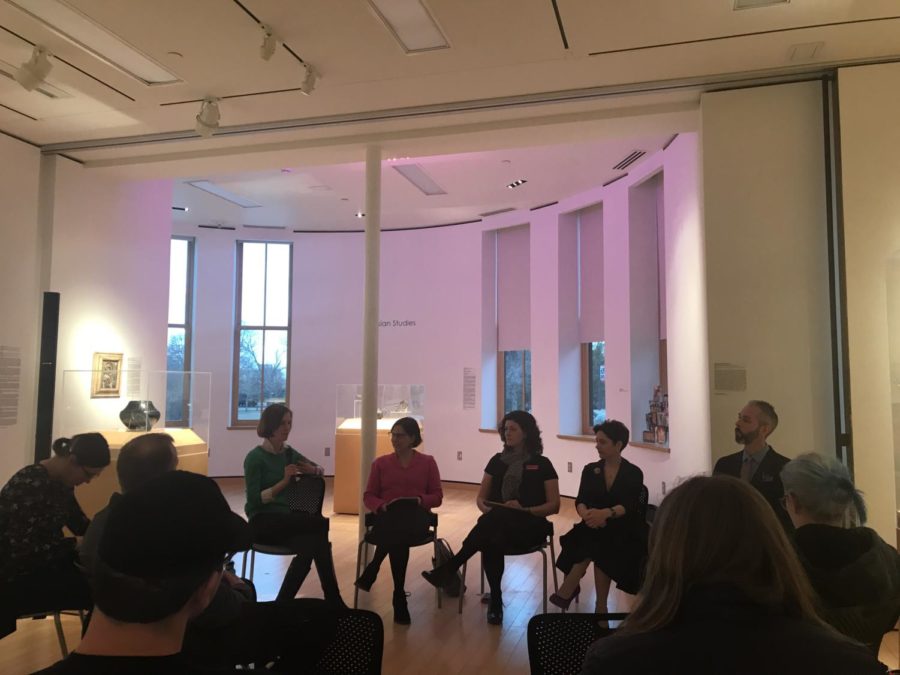Roundtable discusses global art exhibit
In the Christian Petersen Art Museum in Morrill Hall, there was a “Roundtable Discussion: Creating Global Understanding” in which five contributors to an art exhibition discussed their experiences in the collaboration and creation of the exhibit.
March 5, 2020
There was a “Roundtable Discussion: Creating Global Understanding” Thursday in the Christian Petersen Art Museum in Morrill Hall in which five contributors to an art exhibition discussed their experiences in the collaboration and creation of the exhibit.
Eight different programs within the World Languages and Cultures Department at Iowa State each curated a different area of art pieces that are displayed in the museum in Morrill Hall.
Michele Schaal, associate professor of French and women’s and gender studies, came up with the idea, and Adrienne Gennett, University Museums associate curator, was part of the process in creating this exhibit. The two of them, as well as a group of curators from different departments took these objects that Iowa State has collected to highlight these certain objects and cultures.
They wanted to talk about the connections between cultures and how these objects that don’t really have anything in common, actually do connect somehow. The point of this exhibition is to show the positives in art culture and not negatives.
“Art has a lot of possibilities and opportunities to build bridges and open doors,” Schaal said. “Now unfortunately in history and now there will be fascist, racist and homophobic art. But you will also find art that challenges stereotypes and speaks to you. And I think that is the fundamental power of art.”
This event featured each panelist an opportunity to explain their process in this project.
Gennett said for her job, the purpose of curating the art is to tell a story. By using art, she is not only telling a story but getting an opportunity to hear other people’s perspectives and stories as well.
Gennett said she uses the art in the exhibitions she creates in order to hear ideas and interpretations, to help not only others, but herself and to see these pieces in a different light.
Lucia Suarez, director of U.S. Latino/a Studies and associate professor of Spanish, said she became interested in this project due to her love of art that she’s had ever since she was a child. Her love of artwork led to her doing curation prior to this one.
Suarez went on to explain her pieces that she curated for this exhibit at Iowa State. She said the artwork she chose is inspiring in the way it portrays a message of community. Especially when the artist often speaks on the concept of migration, where the art brings attention to topics like immigration and brings attention to the fact that humanity is being denied, that the focus of her art is human beings.
Following, Rachel Meyers, assistant professor of classical studies, said while she doesn’t have experience in museums or curating, her main focus of research is ancient Rome and how art is incorporated in ethics, mythology, etc. in ancient classical studies.
Meyers goes on to explain that ancient art is very different, because unlike what Suarez was saying over her art pieces, ancient art isn’t always identifiable by artist or even exact time of when it was made. She said it can be quite different in how people understand the art and how there are many deductions to be made about the art because there can be a lack of knowledge on the pieces.
Schaal spoke on how when growing up in France, she was very lucky to have affordable access to museums, especially art museums. She said art comes in many forms like paintings and sculptures, however, it can also be things like pottery and literature.
Schaal also explained how she uses art in her classes, going to the extent of having the museum employees come into her class and be a part of her final exam of their class. She also talked about her pieces that she chose, such as a tapestry and a book, and how the history behind them holds many stories.
William Carter, associate professor of German, said he really wasn’t interested in art and museums until he was in college in Washington D.C. He said he grew a new understanding of artists and how they work when he came to the realization of how much effort goes into making art.
Carter spoke about the pieces he had curated, like a music box, and how there are stories and history behind something like a music box, specifically this music box. He said stories about different artifacts show cultural similarities, but more importantly cultural differences.

















